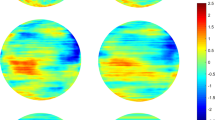Abstract
The statistical problem addressed in this paper is to approximate the P value of the maximum of a smooth random field of Wilks’s Λ statistics. So far results are only available for the usual univariate statistics (Z, t, χ2, F) and a few multivariate statistics (Hotelling’s T 2, maximum canonical correlation, Roy’s maximum root). We derive results for any differentiable scalar function of two independent Wishart random fields, such as Wilks’s Λ random field. We apply our results to a problem in brain shape analysis.
Similar content being viewed by others
References
Adler R.J. (1981). The geometry of random fields. Wiley, New York
Adler R.J. (2000). On excursion sets, tube formulae and maxima of random fields. Annals of Applied Probability 10(1): 1–74
Adler R.J. and Hasofer A.M. (1976). Level crossings for random fields. Annals of Probability 4: 1–12
Anderson T.W. (1984). An introduction to multivariate statistical analysis, 2nd edn. Wiley, New York
Beaky M.M., Scherrer R.J. and Villumsen J.V. (1992). Topology of large scale structure in seeded hot dark matter models. Astrophysical Journal 387: 443–448
Cao J. and Worsley K.J. (1999). The detection of local shape changes via the geometry of hotelling’s t 2 fields. Annals of Statistics 27: 925–942
Cao J. and Worsley K.J. (1999). The geometry of correlation fields with an application to functional connectivity of the brain. Annals of Applied Probability 9: 1021–1057
Cao J., Worsley K.J. (2001). Applications of random fields in human brain mapping. In: Moore M. (eds). Spatial statists: Methodological aspects and applications. (pp. 169–182) Springer Lecture Notes in Statistics 159.
Friston K., Büchel C., Fink G.R., Morris J., Rolls E. and Dolan R.J. (1997). Psychophysiological and modulatory interactions in neuroimaging. Neuroimage 6: 218–229
Gott J.R., Park C., Juskiewicz R., Bies W.E., Bennett D.P., Bouchet F.R. and Stebbins A. (1990). Topology of microwave background fluctuations: Theory. Astrophysical Journal 352: 1–14
Hasofer A.M. (1978). Upcrossings of random fields. Advances in Applied Probability 10: 14–21
Letac G. and Massam H. (2001). The moments of wishart laws, binary trees and the triple products. Comptes Rendus de l’Académie des Sciences - Series I - Mathematics 333(4): 377–382
Magnus J.R. and Neudecker H. (1988). Matrix differential calculus with applications in statistics and econometrics. Wiley, New York
Mardia K.V., Kent J.T. and Bibby J.M. (1979). Multivariate analysis. Academic Press, New York
Muirhead R.J. (1982). Aspects of multivariate statistical theory. Wiley, New York
Neudecker H. (1969). Some theorems on matrix differentiation with special reference to kronecker matrix products. Journal of the American Statistical Association 64(327): 953–963
Olkin I. and Rubin H. (1962). A characterization of the wishart distribution. Annals of Mathematical Statistics 33(4): 1272–1280
Shapiro S.S. and Gross A.J. (1981). Statistical modeling techniques. Marcel Dekker, New York
Taylor J. and Worsley K. (2008). Random fields of multivariate test statistics, with an application to shape analysis. Annals of Statistics 36: 1–27
Taylor J.E., Takemura A. and Adler R.J. (2005). Validity of the expected Euler characteristic heuristic. Annals of Probability 33(4): 1362–1396
Tomaiuolo F., Worsley K.J., Lerch J., Di Paulo M., Carlesimo G.A., Bonanni R., Caltagirone C. and Paus T. (2005). Changes in white matter in long-term survivors of severe non-missile traumatic brain injury: A computational analysis of magnetic resonance images. Journal of Neurotrauma 22: 76–82
Vogeley M.S., Park C., Geller M.J., Huchira J.P. and Gott J.R. (1994). Topological analysis of the CfA redshift survey. Astrophysical Journal 420: 525–544
Worsley K.J. (1994). Local maxima and the expected euler characteristic of excursion sets of χ2, f and t fields. Advances in Applied Probability 26: 13–42
Worsley K.J. (1995). Boundary corrections for the expected Euler characteristic of excursion sets of random fields, with an application to astrophysics. Advances in Applied Probability 27: 943–959
Worsley K.J. (1995). Estimating the number of peaks in a random field using the hadwiger characteristic of excursion sets, with applications to medical images. Annals of Statistics 23: 640–669
Worsley K.J., Cao J., Paus T., Petrides M. and Evans A. (1998). Applications of random field theory to functional connectivity. Human Brain Mapping 6: 364–367
Worsley K.J., Marrett S., Neelin P., Vandal A.C., Friston K.J. and Evans A.C. (1996). A unified statistical approach for determining significant signals in images of cerebral activation. Human Brain Mapping 4: 58–73
Worsley K.J., Taylor J.E., Tomaiuolo F. and Lerch J. (2004). Unified univariate and multivariate random field theory. Neuroimage 23: S189–S195
Yeh J. (1974). Inversion of conditional expectations. Pacific Journal of Mathematics 52(2): 631–640
Zabell S. (1979). Continous versions of regular conditional distributions. Annals of Probability 7(1): 159–165
Author information
Authors and Affiliations
Corresponding author
Additional information
F. Carbonell’s work was supported by a postdoctoral fellowship from the ISM-CRM, Montreal, Quebec, Canada.
About this article
Cite this article
Carbonell, F., Worsley, K.J. & Galan, L. The geometry of the Wilks’s Λ random field. Ann Inst Stat Math 63, 1–27 (2011). https://doi.org/10.1007/s10463-008-0204-2
Received:
Revised:
Published:
Issue Date:
DOI: https://doi.org/10.1007/s10463-008-0204-2



